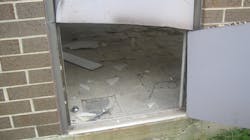Forcible Entry for Outward-Swinging Doors: The Doggy Door
Science is further proving to us as firefighters that we must be strategic in coordinating our ventilation and extinguishing efforts when operating on the fireground. To get water onto the fire quickly requires that we are able to get access to it in an expedient manner. Many times our efforts to gain entry to a structure are challenged by extreme security measures that further delay getting water to the fire. Forcible entry is more than just trying to "kick" or "beat" a door down; it is a firefighting basic that thoroughly needs to be understood by every firefighter before they "hit the street."
Most inward-opening doors can be forced by driving a Halligan bar as a fulcrum between the door and the jamb. Outward-swinging doors can be forced by driving the adz end of a Halligan bar between the door and the jamb and then prying outward. Attacking the hinges of a door will, a lot of times, prove to be the quickest and most efficient method for entry. In cases with external hinges, it may be easiest to cut the hinges with a circular saw if the hinges are exposed. Firefighters may also be faced with bars or other devices that are often used on the inside of outward-swinging doors to provide increased security. This is especially true when speaking of commercial buildings. These devices sometimes can be recognized by bolt heads on the exterior of the door. These can be removed by using a circular saw to cut through the bolt heads, separating them from the shanks. The device will usually then fall off the door, allowing it to open.
Another technique that is applicable to forcing outward-swinging doors when confronted by multiple obstacles is to perform what is known as the "doggy door" cut. It is a very simple technique that is very quick to perform. This is a cut that is placed into the door to allow the bottom portion to swing open free of any obstacles.
To execute the doggy door cut for forcing an outward-swinging door:
- Identify that the door is outward-swinging by the presence of exposed hinges. Attempt to open the door to make certain that it is in fact locked.
- With a circular saw (with the appropriate blade for the door material) make a cut from one side of the door jamb to the other. It is imperative that this cut is located below the locking mechanism or obstacle.
- Once the cut is complete, insert a Halligan bar between the door and jamb while prying outward. The door should swing open freely.
- At this point, a firefighter can reach in and unlock and open the top portion of the door.
Once completed, controlling the door forced cannot be over emphasized. The traditional fire curve that veteran firefighters were taught no longer exists; fires in modern structures starve themselves of oxygen and enter a decay stage until ventilation is introduced allowing them to exponentially take off once provided the needed oxygen. Often times, this ventilation is being provided by the firefighting crew forcing entry into the structure. Changes to fire dynamics happen rapidly once ventilation is introduced. Without a hoseline in place, pressure inside the structure will try to equalize (basic principles of physics) and fire will spread. Without controlling the door, recent studies have shown that the firefighter tenability threshold is exceeded within 90 seconds—what does this mean for any occupants that may be trying to exit the structure through the flowpath now created? In simple terms, we need to get water onto the fire very quickly once we create a ventilation opening.
All options must be considered when it comes to a successful operation. To be successful will require us to be at our best. Are you and your crew prepared to meet the challenge?
JEFFREY PINDELSKI, CFO, is the deputy chief of operations for the Downers Grove, IL, Fire Department and is a 25-year plus student of the fire service. Pindelski has achieved a Master’s degree in Public Safety Administration from Lewis University, a graduate certificate in Managerial Leadership and a Bachelor’s degree from Western Illinois University. He is the co-author of the text R.I.C.O.—Rapid Intervention Company Operations and is a revising author of the third edition of the Firefighter’s Handbook. Chief Pindelski was a recipient of the State of Illinois Firefighting Medal of Valor in 1998.
